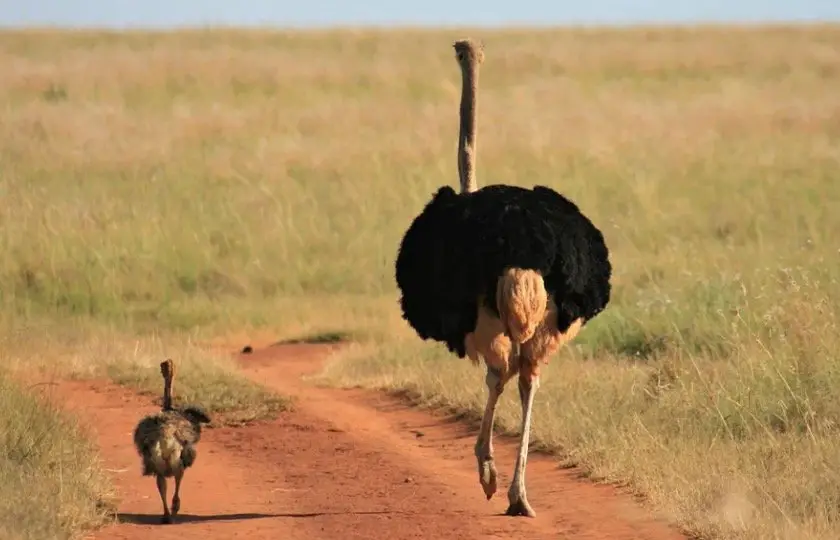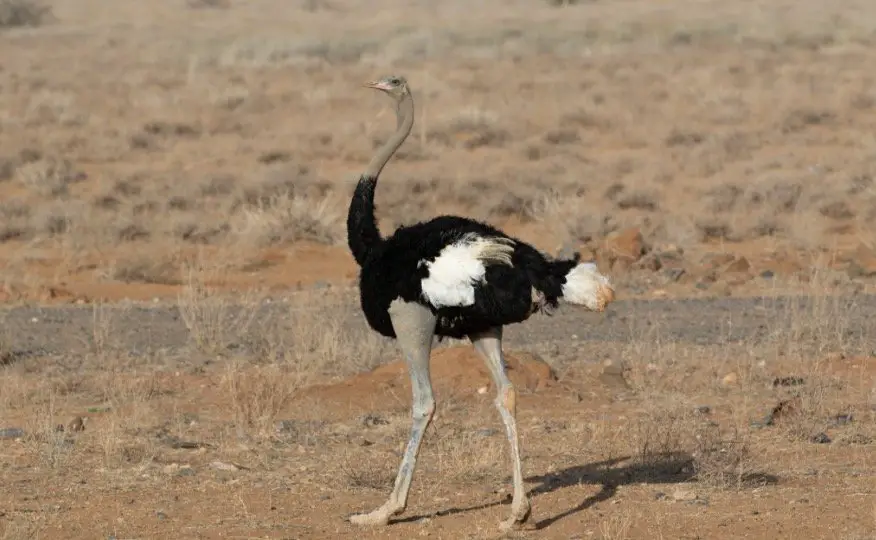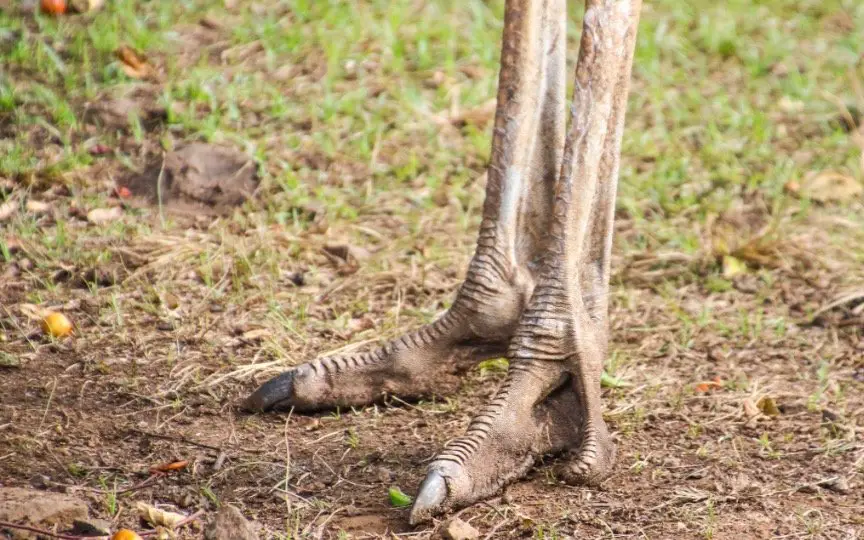How Fast Can an Ostrich Run? All You Need To Know

Table of Contents
How Fast Can an Ostrich Run?
The common ostrich is the world’s biggest and heaviest bird. These huge birds may weigh up to 150 kg and stand 2.8 m tall. Ostriches cannot fly because they are considerably too huge and heavy.
Ostriches depend on their strong legs to go from point A to point B, but their wings also play a role, despite the fact that they are flightless. So, how fast can an ostrich run, and how did they learn to sprint despite their massive size and weight?

Ostriches can sprint at speeds ranging from 40 to 45 miles per hour and cover a massive 5 metres in a single stride. They have been reported to reach speeds of 60mph in brief bursts, making them the fastest two-legged terrestrial mammal in the world.
Ostriches have incredible stamina and can sustain speeds of 30mph to 38mph for up to half an hour or more. That implies they can complete a 26-mile marathon in 35 to 40 minutes. In contrast, the human marathon record is little more than 2 hours.
Aside from their world-record height, weight, and speed, ostriches have the biggest vision of any bird and can spot enormous predators such as lions and hyenas from 2 miles away. In fact, their eyeballs are larger than their brains, with a circumference of 5 cm!
Continue reading to learn more fascinating facts about this enormous and one-of-a-kind bird.

Is an Ostrich the fastest running bird?
There are only two ostrich species in the world: the Common ostrich and the Somali ostrich. The largest ostrich is the Common ostrich, although Somali ostriches aren’t far behind.
Both species of ostrich can run at speeds of up to 40 mph and cover 5 metres in a single step. Over short distances, some ostriches have been clocked to attain speeds of up to 60mph.
This easily qualifies the ostrich as the world’s fastest running bird. They are, in fact, the quickest land sprinting birds on two legs.
How do Ostriches run so fast?
Ostriches have three anatomical traits that aid in their incredible speed and stamina: Their massive, springy legs are paired with robust, well-developed upper-leg muscles. Their ideal center of gravity While running, their wings stabilize and steer them.
Ostriches have enormous legs that range in length from 40 cm to 55 cm. Because of their big, long, and strong tendons, their legs hold twice as much elastic energy as human legs. Large, well-developed leg muscles power ostrich legs, allowing the full length of the leg to swing forth and back at fast rates.
Their legs are very big and strong; a well-placed ostrich kick may kill a lion. Furthermore, ostriches have large, spherical, and balanced bodies that allow them to stay steady despite their considerable height. Their center of gravity is optimal for running.
Despite not being able to fly, ostriches utilize their big 2 m wings to help them keep balanced at fast speeds, which is necessary to prevent them from falling and injuring themselves when running.

Why do Ostriches run fast?
Ostriches are biologically designed to run. Their legs are incredibly lengthy and have strong, elastic tendons.
Ostrich legs are highly developed for running, and their centre of gravity guarantees stability even at speeds of up to 45mph – they’re among the best long-distance runners in the animal world.
Ostriches required to acquire strong legs to evade predators and migrate across territory in search of food, water, and nesting sites since they are so heavy and can’t fly.
Ostriches are very resistant to predators due to their speed and stamina, as well as their exceptional vision and proclivity to dwell in groups of 10 to 12.
The amazing sprinting ability of ostriches allow them to obtain food and other resources amid the vast, parched Africa plains and savannah.
Other birds would simply fly from location to location in search of food, water, nesting places, and so on, but since ostriches are too heavy to fly, they have evolved to sprinting from point A to point B instead.
How long can an Ostrich run for?
Ostriches can run for lengthy periods of time without stopping. An ostrich could complete a marathon (26 miles) in roughly 40 minutes or less if it maintained a pace of around 30mph.

How far can an Ostrich run in a day?
It’s difficult to predict how far an ostrich can run in a day. While we know that ostriches are excellent long-distance runners, there are few, if any, instances in which humans can determine how far ostriches can go before reaching their limitations.
In theory, if an ostrich can maintain speeds of 30 miles per hour for an hour, it might traverse 180 miles in a 12-hour day with one hour of rest between each 1-hour running phase. Ostriches presumably don’t run for the purpose of running, but rather to avoid danger or obtain food and water.
Can all Ostriches run fast?
There are two types of ostriches: common ostriches and Somali ostriches. Both are very fast runners, capable of sprinting at speeds in excess of 45 miles per hour. The common ostrich is somewhat faster.
Can an Ostrich outrun a Cheetah?
No terrestrial species can outrun a cheetah – cheetahs are the fastest land animals in the world, reaching speeds of 75mph – significantly quicker than an ostrich even at top speed!
Cheetahs would almost never hunt ostriches, since they are much too large and powerful to kill a cheetah with a single kick. There is less difficult prey at risk than ostriches!

Can an Ostrich outrun a Lion?
Over a long distance, an ostrich will easily outperform a lion, yet lions have comparable sprint speeds as ostriches, albeit they can only maintain them for short periods of time. If the lion got near enough, a well-timed assault might easily take down an ostrich.
Ostriches, on the other hand, are not easy prey for lions or other predators. An ostrich, with its outstanding vision, strength, speed, and endurance, is more than capable of defending itself against one or more lions. Ostriches often dwell in groups of 10 to 12 ostriches, making them even more difficult to assault.
Can a Human outrun an Ostrich?
A person would never be able to outpace an ostrich. Ostriches can outrun humans by more than double their speed. Their peak speed of 45mph is much beyond the human sprint world record of roughly 27mph. No person, past or present, can outrun an ostrich, not even over a short distance, much alone a long one!
What to do if an Ostrich chases you?
Ostriches are not very aggressive unless they are defending themselves or their young, although they will attack if surprised or provoked. They are aware of their size and power and are not afraid to defend themselves; after all, they live amid many enormous and deadly predators.
The conventional wisdom is to avoid getting too near to an ostrich in the first place. Maintain a safe distance of around 100 metres. If an ostrich approaches you, back away slowly. If it comes too near, shrink yourself by laying on your front and protecting your head. At all costs, avoid the kick.
Can Ostriches kill humans?
Ostrich legs aren’t simply useful for running; they’re also deadly weapons. An adult lion may be killed with a single ostrich kick. Human deaths from ostrich kicks have occurred, however they are uncommon and mainly occur when humans agitate wild ostriches.









